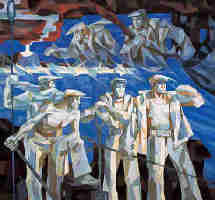
Grotto and temple mural paintings of different dynasties ranging from the Wei Dynasty (220-265AD) to the Ming (1368-1644BC) and Qing (1644-1911) Dynasties, varied a lot in composition. In the Kezier Grotto of Northwest China's Xinjiang Uigur Autonomous Region, the mural paintings within feature a rhombic (parallelogram of equal side and slanting angles) composition of the Buddhism stories. The NO.21 grotto of the Kumutula Grottos has a radiant composition, with a round design pattern in the ceiling as its center and 13 trapezoid-shaped grids radiating from it. Within each grid there is a figure of Bodhisattva.
The "Deer King" (section) cave 257 of Dunhuang Grotto in Northwest China's Gansu Province, features a horizontal composition. Mural paintings retelling the story of the deer king are arranged from left to right. The other type of Dunhuang mural paintings usually feature grand scene of various activities, with the Buddha at the center and Bodhisattva, music players, dancers, ponds and water lilies surrounding it.
The composition of the temple's mural paintings also has unique characteristics. For example, the Mandala mural painting in one of Tibet's Buddhist temple, with its combination of the round and square shapes, expresses the principle of the natural life and death cycle that humans can't exceed, and has kind of unique artistic charm.
The mural painting in the Yongle Palace of the Yuan Dynasty(1206-1368) has the same type of composition with those in the Ming Dynastyin Fahai temple in Beijing, which features a parallel composition.
Some modern mural paintings use traditional composition forms. For example, the rhombic composition form of the mural painting in the Kezier Grotto in Xinjiang Uigur Autonoumous Region has been applied in "The Beautiful Land of the Country ", which is a modern mural painting, and the way of expression of the Han Dynasty's stone mural paintings are also employed in modern mural painting.











